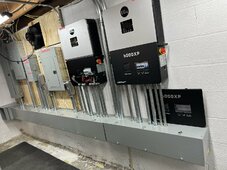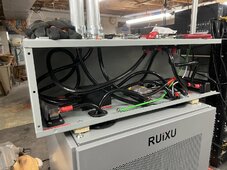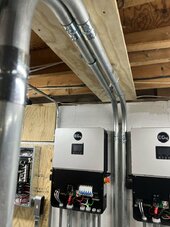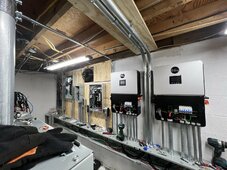(Note: The comments below are based on my non-electrician research and, AIUI, are relevant only if you are in a jurisdiction that has adopted NEC 2023 as their code basis. And even if they have, it's possible there are local overrides. YMMV
If you want to check my work by doing your own reading, the 2023 NEC is available for free, in a somewhat clunky page by page way, if you click on the "View Free Access" button near the bottom of the following page:
Stay informed and participate in the standards development process for NFPA 70

www.nfpa.org
You need to sign up for a free account. There are lots of paths on the web site that give the impression you need to subscribe. You do not. And AIUI, the NFPA has been taken to task for trying to always charge for access to these things, even though they are woven into very public regulations.)
I'm in the planning stages for a very similar setup right now. The project is in Michigan which recently adopted NEC 2023.
TL;DR; - The 2023 version of the code has language that very explicitly allows PV DC to co-locate with AC and battery DC subject to marking requirements and that all conductors (including data cables) have a voltage rating at or above the highest expected voltage in the raceway, which is typically going to be the PV DC voltage. Details below.
I have spent quite a bit of time trying to wade through the text of the standard as well as the various interpretations here and on some other forums. On this particular point, AIUI, the 2023 version was updated to address the fact that we now have quite a lot of highly integrated units like the 6000XP, that make it quite difficult to physically separate the PV DC wiring from the AC runs and battery DC runs and in fact seem to encourage the kind of neatly integrated conduit/raceway setup shown in the photos up-thread.
The specific section that I understand to have been revised is 690.31 - Wiring Methods. (Section 690 is the one that covers Solar PV Systems generally)
Sub-section (B)(1) contains the following language covering exceptions to the requirement to separate PV DC circuits.
"Exception: Where all conductors or cables have an insulation rating equal to at least the maximum circuit voltage applied to any conductor within the same wiring method, the following shall be permitted
(1) Multiconductor jacketed cables for remote control signaling, or power-limited circuits shall be permitted within the same wiring enclosure, cable, or raceway as PV system dc circuits where all circuits serve the PV system
(2) Inverter output circuits shall be permitted to occupy the same junction box, pull box or wireway with PV system dc cuircuts that are identified and grouped as required by 690.31(B)(2) and (B)(3)"
I won't go on to transcribe the rest, but I'll say that the marking requirements mentioned in (2) above are pretty basic and even contain an exception where the difference between the PV DC and other wiring is obvious due to physical spacing, which I'd argue it clearly is in most of these highly integrated inverter setups.






